warning CHEVROLET TRACKER 1998 1.G Owner's Manual
[x] Cancel search | Manufacturer: CHEVROLET, Model Year: 1998, Model line: TRACKER, Model: CHEVROLET TRACKER 1998 1.GPages: 386, PDF Size: 21.17 MB
Page 223 of 386
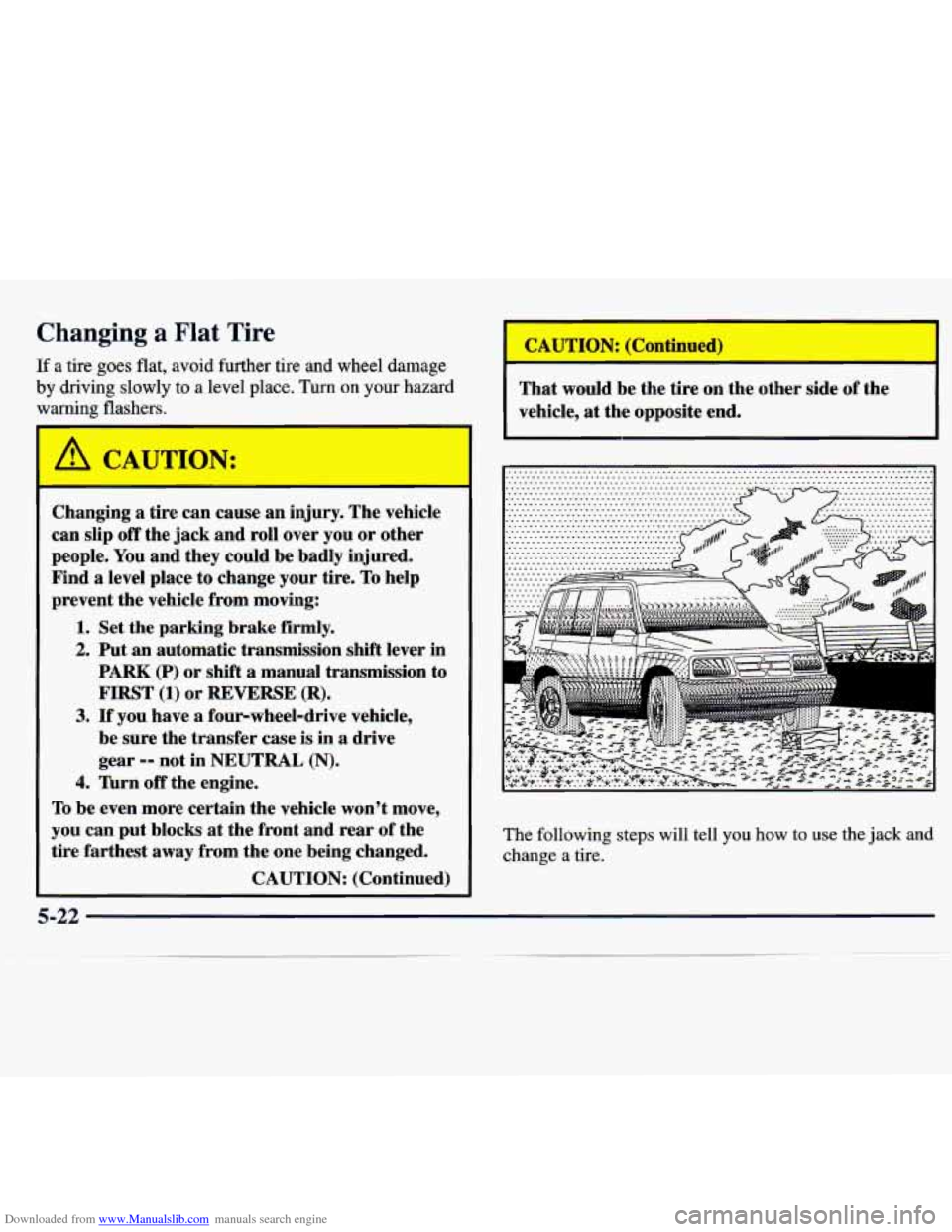
Downloaded from www.Manualslib.com manuals search engine Changing a Flat Tire
If a tire goes flat, avoid further tire and wheel damage
by driving slowly to a level place. Turn on your hazard
warning flashers.
A CAUTION:
Changing a tire can cause an injury. The vehicle
can slip
off the jack and roll over you or other
people.
You and they could be badly injured.
Find
a level place to change your tire. To help
prevent the vehicle from moving:
1. Set the parking brake firmly.
2. Put an automatic transmission shift lever in
PARK
(P) or shift a manual transmission to
FIRST
(1) or REVERSE (R).
3. If you have a four-wheel-drive vehicle,
be sure the transfer case
is in a drive
gear
-- not in NEUTRAL (N).
4. 'hrn off the engine.
To be even more certain the vehicle won't move,
you can put blocks at the front and rear
of the
tire farthest
away from the one being changed.
CAUTION: (Continued) That
would be the tire
on the other side of the
vehicle,
at the opposite end.
The following steps will tell
you how to use the jack and
change a tire.
Page 252 of 386
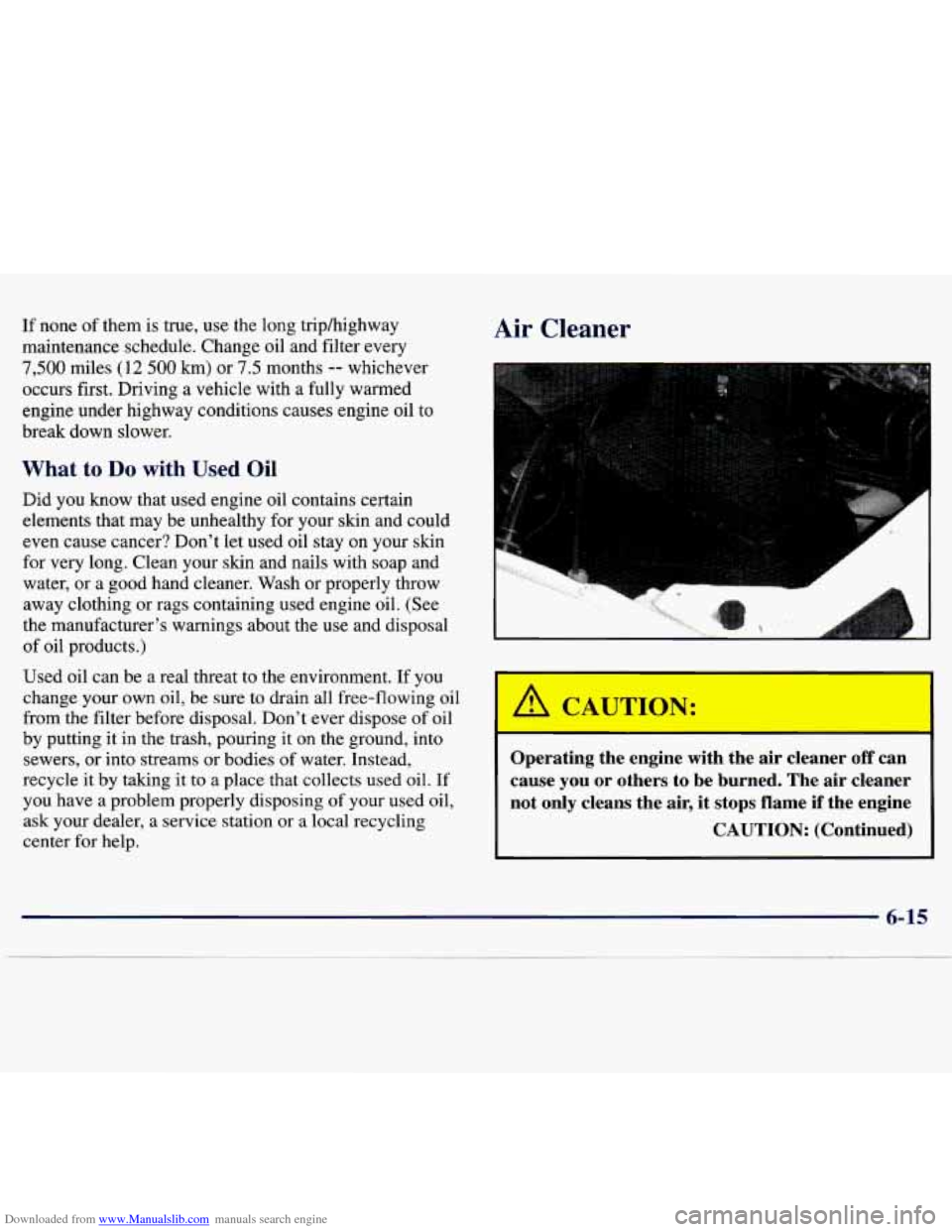
Downloaded from www.Manualslib.com manuals search engine If none of them is true, use the long triphighway
maintenance schedule. Change oil and filter every
7,500 miles (12 500 km) or 7.5 months -- whichever
occurs first. Driving
a vehicle with a fully warmed
engine under highway conditions causes engine oil to
break down slower.
What to Do with Used Oil
Did you know that used engine oil contains certain elements that may be unhealthy for your skin and could
even cause cancer? Don't let used oil stay on your skin
for very long. Clean your skin and nails with soap and
water, or a good hand cleaner. Wash or properly throw away clothing or rags containing used engine oil. (See
the manufacturer's warnings about the use and disposal
of oil products.)
Used oil can be
a real threat to the environment. If you
change your own oil, be sure to drain all free-flowing oil
from the filter before disposal. Don't ever dispose of oil
by putting it
in the trash, pouring it on the ground, into
sewers, or into streams or bodies of water. Instead,
recycle it by taking it to a place that collects used oil. If
you have a problem properly disposing of your used oil,
ask your dealer, a service station or a local recycling
center for help.
Air Cleaner
Operating the engine with the air cleaner off can
cause you
or others to be burned. The air cleaner
not only cleans the air, it stops flame if the engine
CAUTION: (Continued)
Page 261 of 386
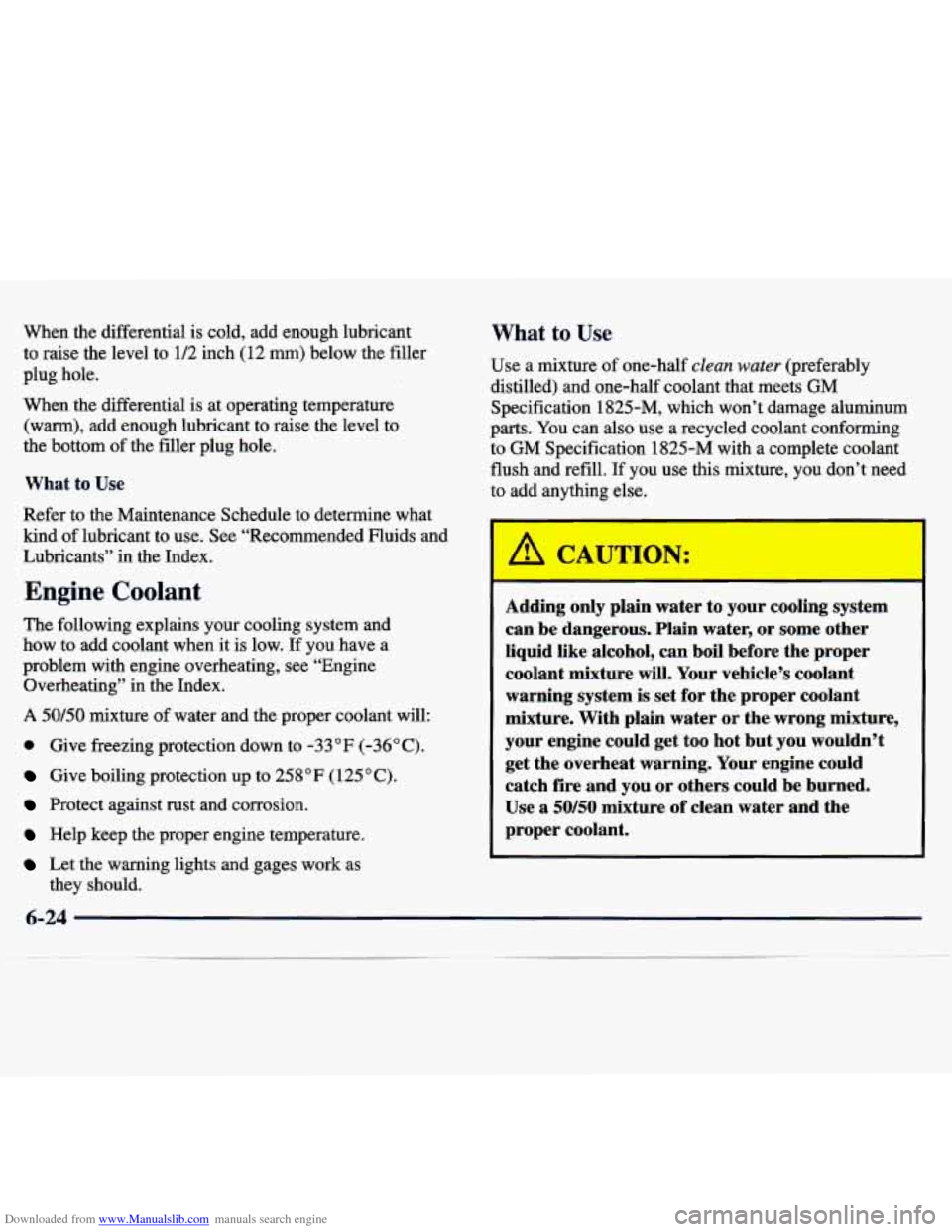
Downloaded from www.Manualslib.com manuals search engine When the differential is cold, add enough lubricant
to raise the level to 1/2 inch (12
mm) below the filler
plug hole.
When the differential is at operating temperature
(warm), add enough lubricant to raise the level to
the bottom
of the filler plug hole.
What to Use
Refer to the Maintenance Schedule to determine what
kind of lubricant to use. See “Recommended Fluids and
Lubricants” in the Index.
Engine Coolant
The following explains your cooling system and
how to add coolant when it is low. If you have a
problem with engine overheating, see “Engine
Overheating” in the Index.
A 50/50 mixture of water and the proper coolant will:
0 Give freezing protection down to -33°F (-36°C).
Give boiling protection up to 258 OF (1 25 O C).
Protect against rust and corrosion.
Help keep the proper engine temperature.
Let the warning lights and gages work as
they should.
What to Use
Use a mixture of one-half clean water (preferably
distilled) and one-half coolant that meets GM
Specification 1825-M, which won’t damage aluminum
parts.
You can also use a recycled coolant conforming
to GM Specification 1825-M with a complete coolant
flush and refill.
If you use this mixture, you don’t need
to add anything else.
Adding only plain water
to your cooling system
can be dangerous. Plain water, or some other
liquid like alcohol, can boil before the proper
coolant mixture will. Your vehicle’s coolant
warning system
is set for the proper coolant
mixture. With plain water or the wrong mixture,
your engine could get
too hot but you wouldn’t
get the overheat warning. Your engine could
catch fire and you or others could be burned.
Use a
50/50 mixture of clean water and the
proper coolant.
Page 269 of 386
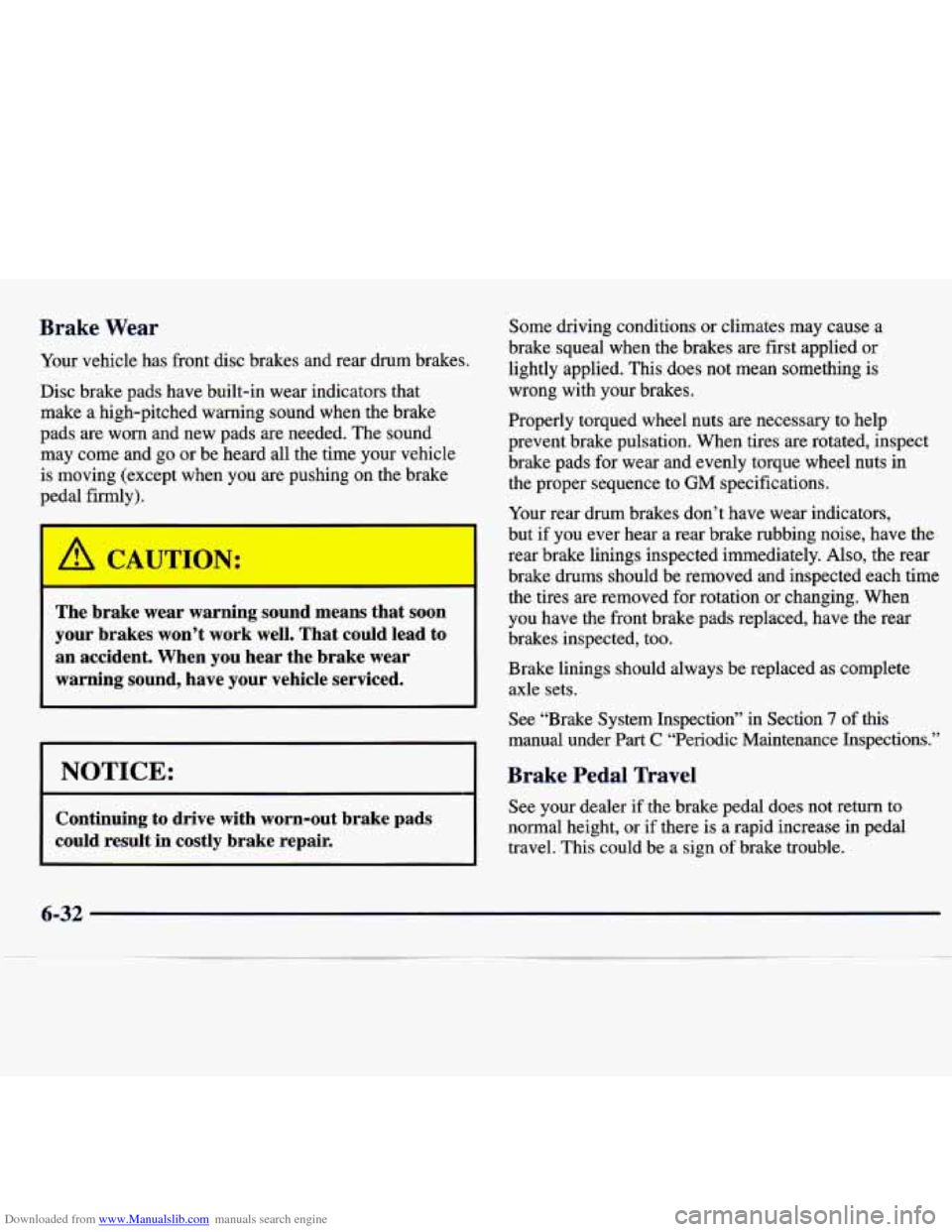
Downloaded from www.Manualslib.com manuals search engine Brake Wear
Your vehicle has front disc brakes and rear drum brakes.
Disc brake pads have built-in wear indicators that
make a high-pitched warning sound when the brake
pads are worn and new pads are needed. The sound
may come and go or be heard all the time your vehicle
is moving (except when you are pushing on the brake
pedal firmly).
The brake wear warning sound means that soon
your brakes won’t work well. That could lead to
an accident. When you hear the brake wear
warning sound, have your vehicle serviced.
NOTICE:
Continuing to drive with worn-out brake pads
could result in costly brake repair.
Some driving conditions or climates may cause a
brake squeal when the brakes are first applied
or
lightly applied. This does not mean something is
wrong with your brakes.
Properly torqued wheel nuts are necessary to help
prevent brake pulsation. When tires are rotated, inspect
brake pads for wear and evenly torque wheel nuts in
the proper sequence to
GM specifications.
Your rear drum brakes don’t have wear indicators,
but if you ever hear a rear brake rubbing noise, have the
rear brake linings inspected immediately. Also, the rear
brake drums should be removed and inspected each time
the tires are removed for rotation or changing. When
you have the front brake pads replaced, have the rear
brakes inspected, too.
Brake linings should always be replaced as complete
axle sets.
See “Brake System Inspection” in Section
7 of this
manual under Part C “Periodic Maintenance Inspections.”
Brake Pedal Travel
See your dealer if the brake pedal does not return to
normal height, or if there is a rapid increase in pedal
travel. This could be a sign
of brake trouble.
6-32
Page 282 of 386
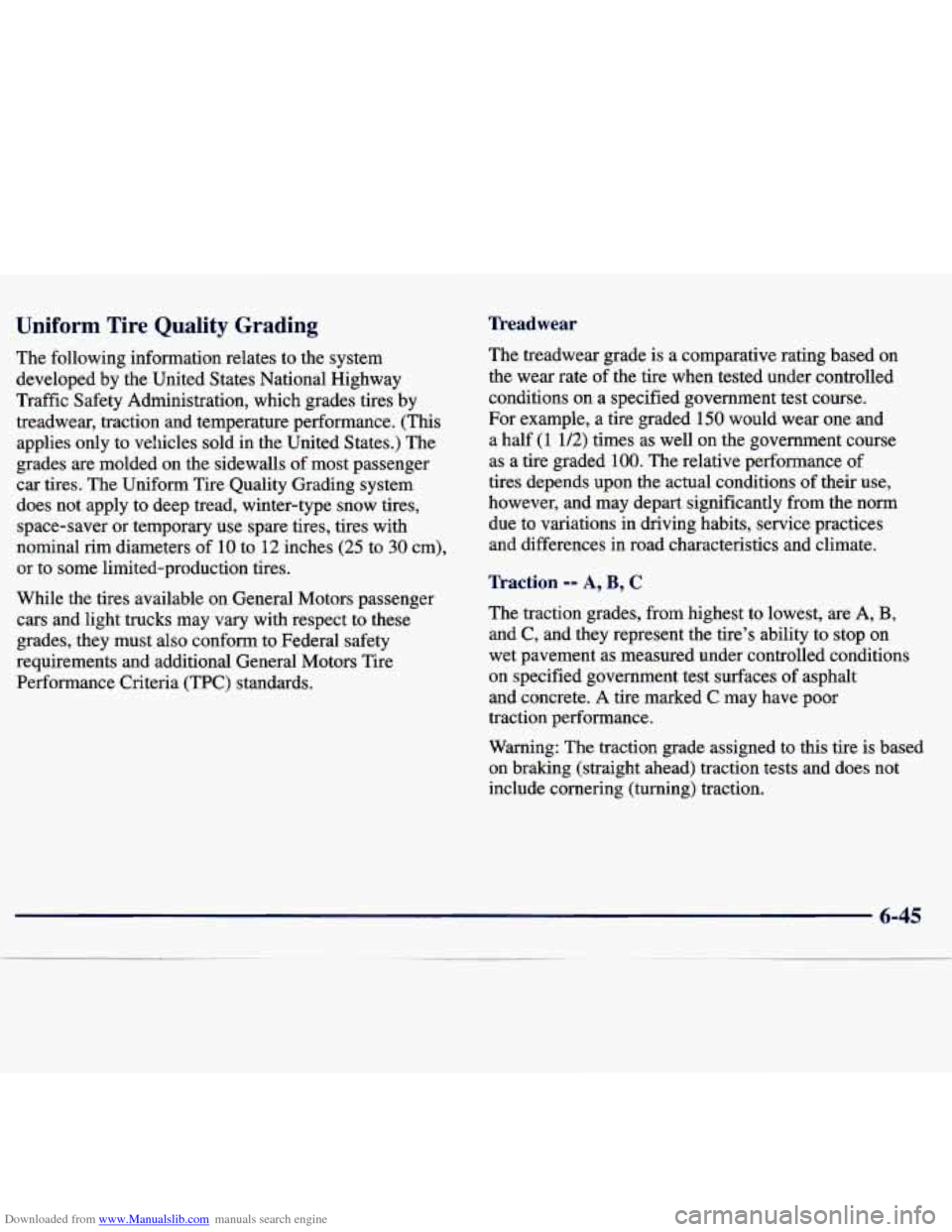
Downloaded from www.Manualslib.com manuals search engine Uniform Tire Quality Grading
The following information relates to the system
developed by the United States National Highway
Traffic Safety Administration, which grades tires by
treadwear, traction and temperature performance. (This applies only to vehicles sold in the United States.) The
grades are molded on the sidewalls of most passenger
car tires. The Uniform Tire Quality Grading system
does not apply to deep tread, winter-type snow tires,
space-saver or temporary use spare tires, tires with
nominal rim diameters of
10 to 12 inches (25 to 30 cm),
or to some limited-production tires.
While the tires available on General Motors passenger
cars and light trucks may vary with respect to these
grades, they must also conform to Federal safety
requirements and additional General Motors Tire
Performance Criteria
(PC) standards.
Treadwear
The treadwear grade is a comparative rating based on
the wear rate of the tire when tested under controlled
conditions on a specified government test course.
For example, a tire graded
150 would wear one and
a half (1 112) times as well on the government course
as a tire graded
100. The relative performance of
tires depends upon the actual conditions of their use,
however, and may depart significantly from the norm
due to variations in driving habits, service practices
and differences in road characteristics and climate.
Traction -- A, B, C
The traction grades, from highest to lowest, are A, B,
and C, and they represent the tire’s ability to stop on
wet pavement as measured under controlled conditions
on specified government test surfaces of asphalt
and concrete.
A tire marked C may have poor
traction performance.
Warning: The traction grade assigned to this tire is based
on braking (straight ahead) traction tests and does not
include cornering (turning) traction.
6-45
Page 283 of 386

Downloaded from www.Manualslib.com manuals search engine Temperature -- A, B, C
The temperature grades are A (the highest), B, and C,
representing the tire’s resistance to the generation of
heat and its ability
to dissipate heat when tested under
controlled conditions on a specified indoor laboratory
test wheel. Sustained high temperature can cause the
material of the tire to degenerate and reduce tire life,
and excessive temperature can lead to sudden tire
failure. The grade
C corresponds to a level of
performance which all passenger car tires must meet
under the Federal Motor Vehicle Safety Standard
No. 109. Grades B and A represent higher levels of
performance on the laboratory test wheel than the
minimum required by law.
Warning: The temperature grade for this tire is
established for a tire that is properly inflated and
not overloaded. Excessive speed, underinflation, or
excessive loading, either separately or
in combination,
can cause heat buildup and possible tire failure.
Wheel Alignment and Tire Balance
The wheels on your vehicle were aligned and balanced
carefully at the factory to give you the longest tire life
and best overall performance. Scheduled wheel alignment and wheel balancing are not
needed. However, if you notice unusual tire wear or
your vehicle pulling one way or the other, the alignment
may need to be reset.
If you notice your vehicle
vibrating when driving on a smooth road, your wheels
may need to
be rebalanced.
Wheel Replacement
Replace any wheel that is bent, cracked, or badly rusted
or corroded. If wheel nuts keep coming loose, the wheel,
wheel bolts and wheel nuts should be replaced. If the
wheel leaks air, replace it (except some aluminum
wheels, which can sometimes be repaired). See your
dealer if any of these conditions exist.
Your dealer will know the kind
of wheel you need.
Each new wheel should have the same load-carrying
capacity, diameter, width, offset and be mounted the same way as the one it replaces.
If you need to replace any of your wheels, wheel bolts
or wheel nuts, replace them only with new
GM original
equipment parts. This way, you will be sure to have the
right wheel, wheel bolts and wheel nuts for your
Chevrolet model.
6-46
Page 285 of 386
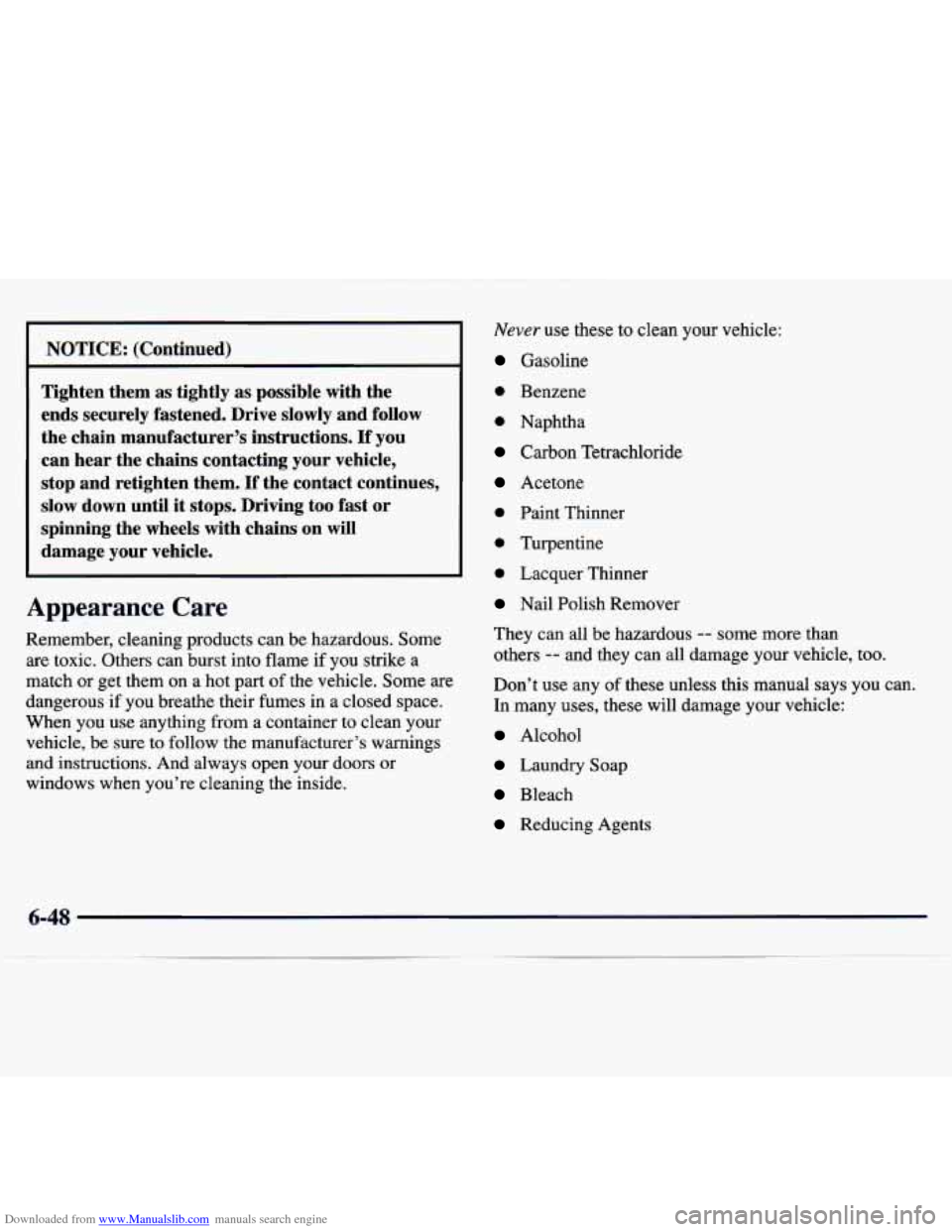
Downloaded from www.Manualslib.com manuals search engine I
NOTICE: (Continued)
Tighten them as tightly as possible with the
ends securely fastened. Drive slowly and follow
the chain manufacturer’s instructions. If you
can hear the chains contacting your vehicle,
stop and retighten them. If the contact continues,
slow down until
it stops. Driving too fast or
spinning the wheels with chains on will
damage your vehicle.
Appearance Care
Remember, cleaning products can be hazardous. Some
are toxic. Others can burst into flame if you strike a
match or get them
on a hot part of the vehicle. Some are
dangerous
if you breathe their fumes in a closed space.
When you use anything from a container to clean your
vehicle, be sure
to follow the manufacturer’s warnings
and instructions. And always open your doors or
windows when you’re cleaning the inside.
Never use these to clean your vehicle:
Gasoline
0 Benzene
0 Naphtha
Carbon Tetrachloride
Acetone
0 Paint Thinner
0 Turpentine
0 Lacquer Thinner
Nail Polish Remover
They can all be hazardous
-- some more than
others
-- and they can all damage your vehicle, too.
Don’t use any
of these unless this manual says you can.
In many uses, these will damage your vehicle:
Alcohol
Laundry Soap
Bleach
Reducing Agents
6-48
Page 296 of 386
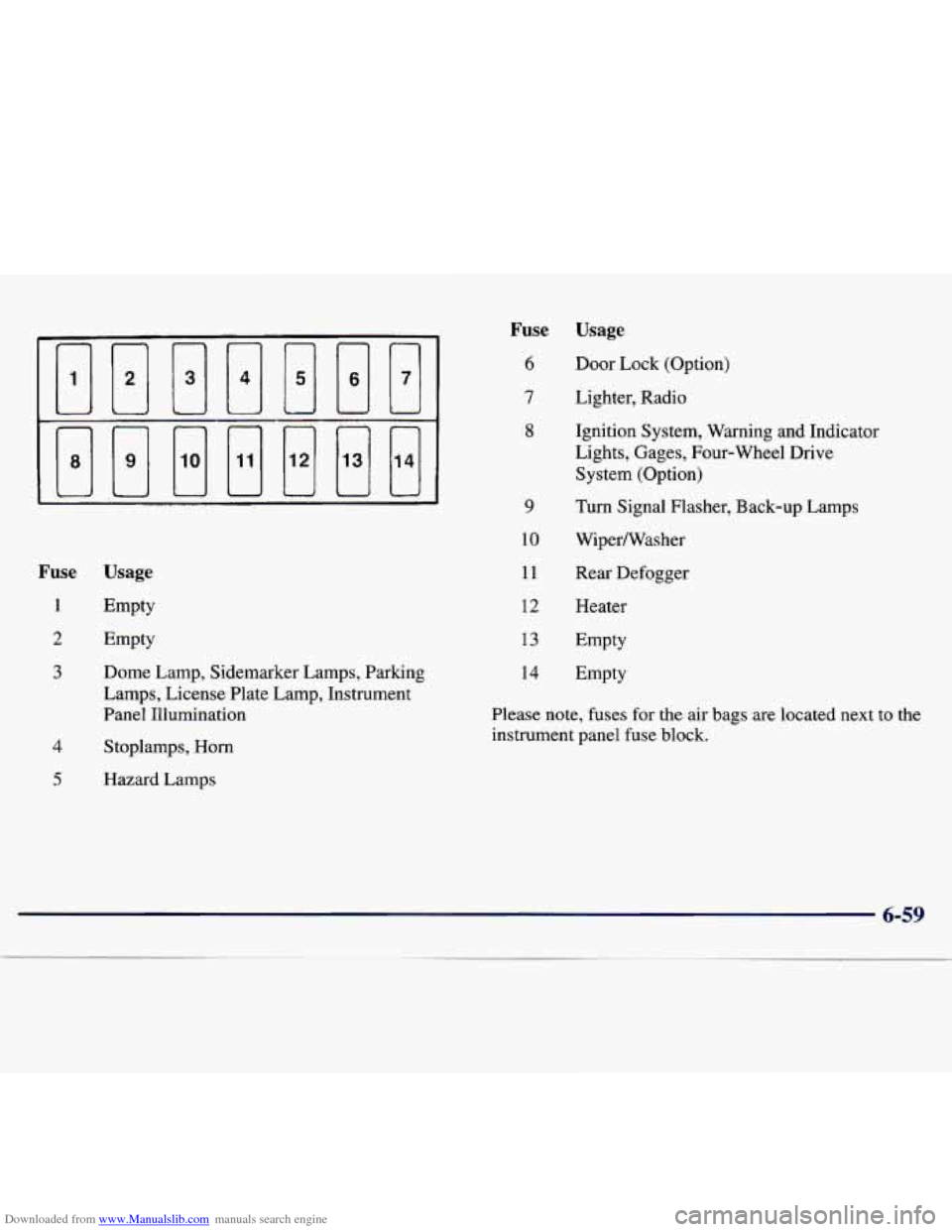
Downloaded from www.Manualslib.com manuals search engine Fuse Usage
1 Empty
2
3
4
5
Dome Lamp, Sidemarker Lamps, Parking
Lamps, License Plate Lamp, Instrument
Panel Illumination
Stoplamps,
Horn
Hazard Lamps
Fuse
6
7
8
9
10 11
12
13
14
Usage
Door Lock (Option)
Lighter, Radio
Ignition System, Warning and Indicator Lights, Gages, Four-wheel Drive
System (Option)
Turn Signal Flasher, Back-up Lamps
Wiperwasher
Rear Defogger
Heater
Empty
Empty
Please note, fuses
for the air bags are located YI IO me
instrument panel fuse block.
6-59
__
Page 374 of 386

Downloaded from www.Manualslib.com manuals search engine 0 Section 9 Index
Adding Equipment to the Outside of Your Vehicle ..... 6-3
Air Bag
....................................... 1-25
Adding Equipment
............................ 1-3 1
How Does it Restrain .......................... 1-29
How it Works ................................ 1-27
Location
.................................... 1-27
Readiness Light
......................... 1-26. 2-59
Servicing
................................... 1-31
What Makes it Inflate
.......................... 1-28
What Will You See After
it Inflates ............... 1-29
When Should it Inflate
......................... 1-28
Aircleaner
.................................... 6-15
Air Conditioning ................................ 3-3
Air Conditioning Refrigerants ..................... 6-63
Alignment and Balance. Tire
...................... 6-46
Antenna
...................................... 3-17
Antifreeze
..................................... 6-24
Anti-Lock Brake System Active Light
................. 2-62. 4.9
Brake System Warning Light
................ 2.61. 4.7
Brakes
...................................... 4-7
Appearance Care Materials
....................... 6-56
Arbitration Program
.............................. 8-9
Ashtrays ...................................... 2-40
Aluminum Wheels. Cleaning
...................... 6-54
AppearanceCare
............................... 6-48 Audio Systems
.................................. 3-6
Automatic
Overdrive
................................... 2-15
Overdrive
Off Switch .......................... 2-15
Automatic Transmission
.......................... 2-9
Check
...................................... 7-48
Fluid
....................................... 6-17
Operation
................................... 2-11
Park Mechanism Check
........................ 7-50
Starting Your Engine
........................... 2-9
Front
....................................... 6-23
Rear
....................................... 6-22
Shifting
..................................... 2-11
Axle
Battery
...................................... 6-33
Jump Starting
................................. 5-3
Warnings
................................ 5.3. 5.4
BBB Auto Line
................................. 8-9
Better Business Bureau Mediation
................... 8-9
Blizzard
...................................... 4-41
Brake
Adjustment
.................................. 6-33
Fluid
....................................... 6-30
Master Cylinder
.............................. 6-29
Parking
..................................... 2-21
Page 375 of 386
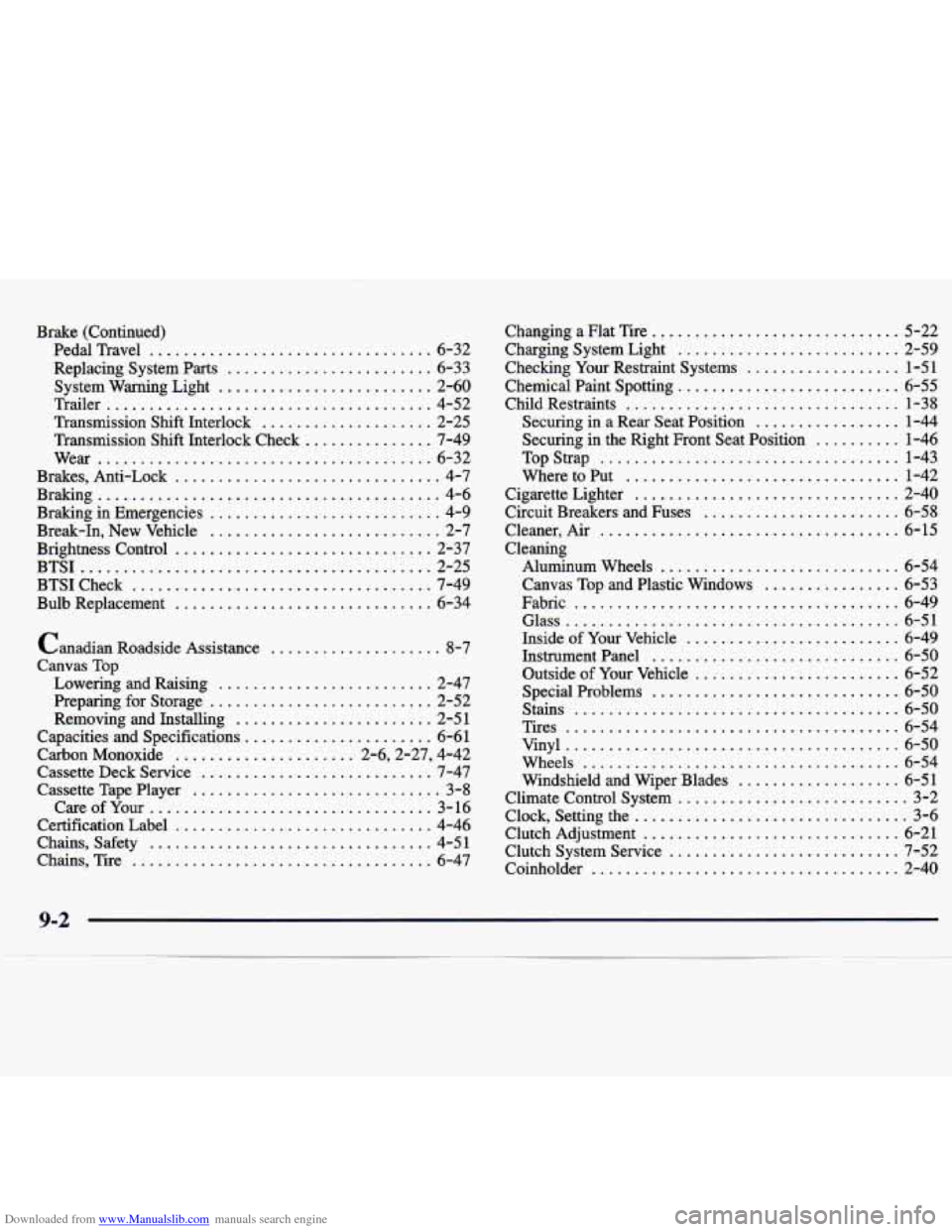
Downloaded from www.Manualslib.com manuals search engine Brake (Continued) Pedal Travel
................................. 6-32
Replacing System Parts
........................ 6-33
System Warning Light
......................... 2-60
Trailer
...................................... 4-52
Transmission Shift Interlock
.................... 2-25
Transmission Shift Interlock Check
............... 7-49
Wear
....................................... 6-32
Brakes. Anti-Lock
............................... 4-7
Braking in Emergencies
........................... 4-9
Break-In. New Vehicle
........................... 2-7
Brightness Control
.............................. 2-37
BTSICheck
................................... 7-49
Bulb Replacement
.............................. 6-34
Braking
........................................ 4-6
BTSI
......................................... 2-25
Canadian Roadside Assistance
.................... 8-7
Canvas Top
Lowering and Raising
......................... 2-47
Preparing for Storage
.......................... 2-52
Removing and Installing
....................... 2-51
Capacities and Specifications
...................... 6-61
Carbon Monoxide
..................... 2.6.2.27. 4.42
Cassette Deck Service
........................... 7-47
Cassette Tape Player
............................. 3-8
CareofYour
................................. 3-16
Certification Label
.............................. 4-46
Chains. Safety
................................. 4-51
Chains. Tire
................................... 6-47 Changing a Flat Tire
............................. 5-22
Charging System Light
.......................... 2-59
Checking Your Restraint Systems
.................. 1-51
Chemical Paint Spotting
.......................... 6-55
Child Restraints
................................ 1-38
Securing in a Rear Seat Position
................. 1-44
Securing in the Right Front Seat Position
.......... 1-46
Top Strap
................................... 1-43
Where to Put
................................ 1-42
Cigarette Lighter
............................... 2-40
Circuit Breakers and Fuses
....................... 6-58
Cleaner. Air
................................... 6-15
Cleaning Aluminum Wheels
............................ 6-54
Canvas Top and Plastic Windows
................ 6-53
Fabric
...................................... 6-49
Glass ....................................... 6-51
Inside of Your Vehicle
......................... 6-49
InstrumentPanel
............................. 6-50
Outside of
Your Vehicle ........................ 6-52
Special Problems
............................. 6-50
Stains
...................................... 6-50
Tires
....................................... 6-54
Vinyl
....................................... 6-50
Wheels
..................................... 6-54
Windshield and Wiper Blades
................... 6-51
Climate Control System
........................... 3-2
Clock. Setting the
................................ 3-6
Clutch Adjustment
.............................. 6-21
Clutch System Service
........................... 7-52
Coinholder
.................................... 2-40